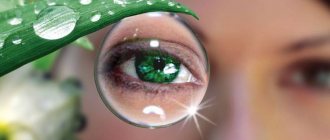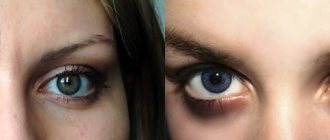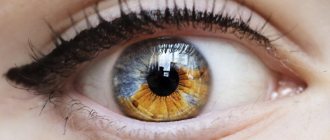Each person is unique and has individual characteristics.
People differ in the color of their hair, eyes, and skin.
There are basic biological eye colors. Some of them are unique; there are only a few of them on the planet. Many people are interested in what determines eye color.
Most people are born with light eyes, mostly blue. With age, they tend to change color or darken. Around the age of 4 years, color characteristics are formed. Every nationality on the planet tends to have certain eyes.
What determines eye color
Eyes are a delicate and important organ in the life of every person, especially girls. This trait can tell a lot about a person's character and preferences. Women choose clothes and makeup exclusively according to eye color. Some representatives of the fair sex attach great importance to this trait. Multi-colored contact lenses are often used to change color.
With the help of such optics, you can give your eyes the desired shade and change it at will. This is a very convenient way to create the desired image. In addition to optical products, Photoshop is also popular. Thanks to this program, you can change and even enlarge your eyes, but only in photographs.
Parents can observe that the child was born with one eye color, but with age it has changed dramatically. Therefore, it is useful for everyone to know what it depends on. There are two factors that affect eye color:
- tissue density.
- quantity and distribution of pigment.
Melanin is a special pigment that affects the color of eyes and hair. The dark or light shade depends on its quantity. It is worth considering that every person’s back layer is always black. Only albinos, who have specific characteristics, do not fall into this group.
Determining eye shade
There are four main eye colors. Mixed types are also known. The iris is as individual as a fingerprint. Physiognomy (a method of determining a person’s character by external facial features), in addition to shade, takes into account saturation and intensity. The artificial technique of reading faces describes the relationship between the concentration of the hue and the makings of a person. For example, the higher the brightness of the iris, the more a person corresponds to the characteristics of his type. Restrained notes minimize negative tendencies.
Blue eyes
A common color that is often found on our planet. Almost all children in Europe are born with it.
In some countries, such as Estonia, almost the entire population lives with this color. There are slightly fewer representatives of such eyes in Germany. This shade is found in people with a small amount of basic pigment.
Blue color
This color occurs due to the low density in the shell, as well as the low content of pigment, which is responsible for the color. This color occurs because the back layer absorbs low light and reflects high light from it.
The eyes take on a blue tint. Saturation depends on the density of the fibers on the outer layer; the higher it is, the brighter the color will be. It is rare to find people with such eyes. The combination with blond hair is considered especially attractive. It rarely occurs in brunettes and red-haired people, as well as dark-skinned people.
Character by eye color – gray-green shade
By nature, pragmatic and hardworking individuals are endowed with eyes of this color. They are characterized by justice, constancy and patience. They perfectly control their emotions and remain impartial in any situation. They win disputes and difficult situations thanks to a cool mind and informed decisions.
Unlike other types of physiognomy, despite their practicality, sobriety and realism, they are able to remain soft and delicate. They know how to show empathy, listen and hear the interlocutor, and also provide the right support. In addition, they received acute intuition, mental flexibility and strong willpower.
Green eyes
Interestingly, this color is popular and desirable. Since ancient times, it was believed that only persons with magical powers had them. Superstitious people are wary of such individuals. But this color has nothing to do with magic. A person acquires it due to an insufficient amount of the main pigment.
The layer may have yellow or brown pigment. Green color results from the scattering of blue and cyan hues. In this case, an uneven color is observed. In addition, green has a large number of shades.
With pure and rich color, people find it very rarely. There are no more than 2% of carriers of this color on the planet. Usually these are representatives of different regions of Europe. More often such eyes are found in female representatives. This gives them a special uniqueness. They are especially in demand in the modeling business.
Brown eyes - common characteristics
People with brown eyes have sensuality and a pronounced temperament. At the same time, their wit can cause acute temper. They are characterized by quick release. Able to easily forget grievances.
Representatives of this type quickly fall in love. For them, the most important thing is the initial stage of the relationship. But very soon they will get bored with the monotony. Especially if there is no response and constant encouragement. They give their warmth only in response to gratitude.
The weakest point is capriciousness. But this drawback is leveled out. After all, brown-eyed people are great at finding a common language with people and achieving what they want.
Grey colour
Interestingly, it has similarities with blue. But at the same time there is an increased density, so the shade is more similar to gray.
With low density, the color may be gray-blue. An admixture of yellow or another color is often observed. People are attractive, charming, special, especially men.
Brown eyes
They are very common throughout the world. This color occurs due to the large amount of the desired pigment on the outer shell. It absorbs any light, and its reflection leads to the formation of a brown tint. Its saturation depends on the amount of melanin. Interestingly, they are actually blue.
Because these eyes are common, they are not unique or special. Therefore, most girls prefer to change color using contact lenses. But it is worth noting that such eyes have a particular advantage - they are most adapted to the sun's rays.
Causes
There is congenital photophobia, in which the eye reacts to daylight or artificial light due to a lack of melanin pigment or its complete absence in the body.
The causes of photophobia can be completely different:
- Diseases of the organs of vision;
- Features of the structure of the eyes (for example, albinism);
- General diseases;
- Adverse environmental influences (excess UV radiation).
Increased eye sensitivity to light can be caused by taking certain medications. For example, to effectively diagnose the fundus of the eye, doctors instill drugs into the eyes that dilate the pupil, as a result of which the retina is exposed to increased exposure to light rays for some time. Photophobia can also become a side reaction to taking medications such as:
- Quinine;
- Tetracycline;
- Doxycycline;
- Belladonna;
- Furosemide.
In recent years, the cause of photophobia of the eyes has increasingly become a long stay at the computer (“computer syndrome”). Increased sensitivity of the eyes to light and wind occurs against the background of constant drying out and visual stress.
Some diseases can also cause a heightened reaction to light in the eyes, such as:
- Conjunctivitis;
- Ulcers and damage to the cornea;
- Tumors;
- Eye keratitis (inflammation of the cornea);
- Iritis (inflammation of the iris);
- Meningitis;
- Diseases of the central nervous system;
- Acute attack of glaucoma ICD 10;
- Retinal detachment (photo);
- Refractive eye surgery.
Photophobia can also occur due to damage to the eye by bright light (for example, with snow ophthalmia, welding without glasses, when looking at the sun, etc.).
Long-term wearing of lenses can also lead to photophobia, especially if they were incorrectly selected. In rare cases, doctors encounter photophobia caused by botulism, mercury poisoning, chronic fatigue, and depression.
Amber
Differs in a large number of light brown shades. Sometimes it can be diluted with yellow, green and even red shades. Dirty swamp or bright yellow color is quite common. This is due to the presence and amount of a unique pigment - lipofuscin.
There are different combinations that make the appearance special and unusual.
There are also hazel, beer and mixed colored eyes. When illuminated, they can change shade and appear different. The swamp color occurs due to a combination of brown, blue and light blue. Sometimes in such eyes the presence of yellow pigment is observed. This color is very beautiful and attractive. Suitable for any hair of every person.
Colors of the iris
Melanin affects not only the color of the shell, but also the skin and hair. The higher its concentration in the body, the more “eastern” a person’s appearance. In other words, the pigment colors brown and black.
Swamp
This is a mixed color. Depending on the light level, it appears nutty, golden, or brown. The concentration of melanin, which gives a brown tint, is low. The amount of blue depends on the thickness of the stromal fibers.
In most cases, the iris of swamp eyes is heterogeneous. There is a significant number of pigment spots on its surface. A similar shade is often found among residents of the Middle East. Only eight percent are its carriers.
Blue
According to scientific luminaries, such eyes do not exist at all. The appearance of a blue tint is caused by a low concentration of melanin and an increased density of stromal fibers. Since the connective tissue is colored exactly this color, the streams of light are reflected from it and give the eyes a blue color. The higher the fiber density level, the lighter the iris shade.
The decrease in the production of color pigment is caused by a genetic mutation that began approximately ten thousand years ago. Blue eye color is the most common among Europeans (about sixty percent of the total population). However, light eyes can also be seen in Asians. Among Jews, the frequency of births of babies with blue eyes reaches fifty percent.
| Blue eyes indicate a small amount of pigment and low density of connective tissue. The lower the second indicator, the more saturated the color. Such eyes are typical for newborn babies. |
Return to contents
Greens
What determines eye color? That's right, it depends on the amount of melanin and stroma density. The “emerald” iris contains a small concentration of the substance. The light brown or hazel pigment merges with the diffuse hue of the connective tissue to produce a green color.
Like swamp eyes, “emerald” eyes do not have a uniform shade, which is evenly distributed over the surface of the iris. Pure green color is extremely rare. According to studies, representatives of the fairer sex most often have a similar eye color.
According to some reports, the “red hair” gene is responsible for the green color of the iris. Owners of “emerald” eyes should definitely wear tinted glasses when out in the sun. Because their eyes are highly sensitive to ultraviolet radiation. Such people are at high risk of developing certain types of cancer, such as melanoma.
Gray
Close “relatives” of blue eyes. But the gray tint is caused by a higher density of the stroma. The color of the iris depends on the degree of light dispersion. With an increased concentration of melanin, yellow or brown spots are observed on the surface of the shell. This eye color is often found among Europeans and residents of Afghanistan and Pakistan.
Brown
The most common color of the iris. An increased concentration of melanin and dense fibers cause dark eye color. The popularity of the shade is explained by its “benefits”. Brown eyes stand up well to the bright sun (important for southern peoples) and blinding glare from snow (an eternal problem for the inhabitants of the north).
As a result of evolution and active migration, a similar shade is found on all continents and in every nationality.
Black
Almost identical in structure to brown eyes. However, the concentration of color pigment in the iris is very high, so light rays striking the shell are almost 100% absorbed. Similar eyes can be found among Asians.
| Their babies are born immediately with an increased concentration of pigment (unlike our blue-eyed babies). A pure black tint is found in albinism. |
Amber
The yellow-copper color is formed when the iris contains lipochrome pigment. This color is extremely rare. It is most widespread in Asia and South America. The shade can vary from golden to copper.
Black eyes
This phenomenon can be found very rarely. But in reality it just appears black.
Dark brown eyes are caused by the required amount of the right pigment in the iris. Moreover, its concentration is very high. When light hits the eyes, it is completely absorbed. That's why they appear rich and black.
Content
The influence of lighting color on humans
Source color temperature
- Warm light
- Natural white light
- Cold light
- Other light source parameters
In the modern world, the vision of every person is under increased strain: computer monitors, TV screens and all kinds of gadgets are constantly in front of our eyes, at work and at home. Therefore, many people who seek to compensate for damage to vision, at least where possible, are concerned about which light is better. In addition, the color of lighting affects the perception of the interior of the room; it can emphasize it favorably or, on the contrary, unpleasantly distort the colors. It follows from this that even such a trifle as choosing a light bulb must be treated with attention.
The influence of lighting color on humans
There is no need to worry about the relationship between the color of lighting fixtures and eye health; it does not affect vision. However, the shade of lighting still has a certain effect on a person; to some extent, our psycho-emotional state and mood depend on it. Warm light promotes relaxation, cold light invigorates and keeps you in good shape, so each of them is good in its place and at its time. Let's figure out which artificial light is better and healthier for the eyes - warm or cool white?
Source color temperature
To find out what the light will be like from an energy-saving or LED lamp, you need to pay attention to the color temperature value indicated on the packaging. The unit of measurement is Kelvin (K). The lower this value, the more yellow the glow will be. Light from a light bulb with a high color temperature has a bluish tint. Most often there are three main lighting colors:
- Warm white – 2700–3500 K.
- Neutral or natural white – 3500–5000 K.
- Cool white – 5000–5400 K.
Warm white lighting with a familiar yellowish tint is comfortable and pleasant to the human eye, its glow is the same as that of yellow sunlight in the early morning or towards sunset. It can be provided by both conventional incandescent and halogen lamps. You can also find fluorescent and LED devices with warm spectrum radiation on sale. Where is the best place to use this light? In the living room. It is recommended to organize warm lighting in rooms where you want to create a relaxed and cozy atmosphere. For example, in a room where the family gathers in the evenings to have dinner and chat.
- In the kitchen. Warm lighting is perfect for the area above the dining table; dishes will look more appetizing and beautiful.
- In the bathroom. Soft, warm light in the bathing area will help you relax.
- In the bedroom. It is in this room that it is especially important to create a feeling of calm and comfort so that the eyes can rest.
Warm spectrum lamps are used by designers to increase the color saturation of interior items in soft tones. Cool shades, on the contrary, will become less noticeable. Blue and green colors will be distorted, this is due to the fact that the light from such a lamp does not contain rays of the corresponding spectrum. Under such lighting, cool tones change as follows: blue may appear greenish; blue will become faded; dark blue will turn to black; purple can be confused with red. That is why you need to think through all the details in advance, before purchasing a lamp, so that the illuminated room does not acquire an undesirable or even unpleasant appearance.
Natural white light
Halogen and some fluorescent lamps provide illumination that is as close as possible to natural white light, so colors are virtually undistorted. It is advisable to install them:
- in children's rooms
- in the hall
- in the kitchen work area
- in a place intended for reading, such as near a chair or in the bedroom above the bed
- next to mirrors, as they accurately convey skin tone.
Cold light
Light in the cold color spectrum is reminiscent of the white winter sun. It is often used in office spaces, as well as anywhere where it is necessary to create a working mood. Neutral and cool shades are suitable for those places where there is supposed to be both natural and artificial lighting, as these tones will help improve concentration. Cold light flux is perceived by the human eye as brighter and more intense.
In apartments, lamps with such radiation are most often used:
- In the kitchen where accent lighting is required for food preparation.
- In the office, because such radiation balances and increases performance.
- In the bathroom, in the wash area, cool bluish lighting will help you invigorate and wake up completely.
- It is recommended to use this spectrum in living rooms when they have a modern design and a lot of free space.
Colors in this lighting are also distorted, but the changes affect only warmish shades.
Red, orange and yellow colors will appear purple, brown and greenish respectively. But blue and green tones, on the contrary, will look rich and rich. Note! The color of lighting is affected not only by the glow of the light bulb, but also by the color of its bulb, as well as the lampshade or lampshade.
Other light source parameters
To choose the right light bulb, it makes sense to pay attention not only to the color, but also to its other parameters. All lighting sources used today are characterized by several characteristics:
Operating principle.
There are LED, fluorescent, halogen, and well-known incandescent lamps.
Flask configuration.
The most common types are pear-shaped, spherical, tubular, mushroom-shaped and so-called spots.
Efficiency
LED lamps have the highest performance today.
Price.
The cheapest light sources are incandescent lamps, the most expensive are LED. At the same time, the latter are environmentally friendly and consume much less electricity.
To understand how the room will look when artificial lighting is turned on, at the time of purchase it is better to further clarify the color rendering index of the light bulb. The letters Ra are used to designate it; ideally, this indicator should be 90 or higher, this will allow you to see the natural colors of objects in a room illuminated by a lamp. If Ra is less than 80, the shades will be distorted. Examples of Ra perception by the eye:
Conclusions and recommendations:
If you want to see real rich colors, choose products from well-known brands, OSRAM, PHILIPS, they are not much more expensive than little-known brands sold in Auchan and Leroy, tested by DKELECTRO!
Our prices for the most popular models of OSRAM LED lamps are:
- Lamp LED lamp CLASSIC P 40 5.4W/830 5.4W ball 3000K heat. white E14 470lm 220-240V FR OSRAM 4052899971615 — 85 rubles
- LED lamp CLASSIC B 40 5.4W/830 5.4W candle 3000K heat. white E14 470lm 220-240V FR OSRAM 4052899971608 — 85 rubles
- LED lamp CLASSIC A 100 11.5W/827 11.5W ball 2700K heat. white E27 1060lm 220-240V FR OSRAM 4052899971578 — 135 rubles
- LED lamp LED STAR CLASSIC B 40 4W/827 230V FIL E14 FS1 OSRAM 4058075068353 —110 rubles
- LED lamp LED STAR CLASSIC BW 40 4W/827 230V FIL E14 FS1 OSRAM 4058075055391 —120 rubles
- LED lamp LED STAR CLASSIC BA 40 4W/827 230V FIL E14 FS1 OSRAM 4058075055452 —120 rubles
Purple
To many people, such eyes may not seem natural. But there are several people on the planet whose eyes are naturally purple.
At the moment there is no scientific explanation for this phenomenon. Scientists are studying the reason for the appearance of this color. There are various myths that have no scientific evidence. Therefore, at the moment this phenomenon is considered a mystery. Most likely, this occurs in connection with pathological processes.
Eyes of different colors - heterochromia
Another unique phenomenon is the presence of eyes of different colors. This is called heterochromia.
This word is of Greek origin and is translated as “different colors.” The reason lies in the different amounts of the main pigment in the iris of each eye. This pathology has several types: complete (eyes of different colors), partial (some parts are multi-colored).
Differential diagnosis
Pigmentary glaucoma must be distinguished from other types of ocular hypertension:
- Primary open-angle glaucoma is sometimes accompanied by hyperpigmentation, but the pigment is concentrated in the lower sector of the angle. Patients are also usually older, and characteristic transillumination defects in the iris and Krukenberg spindle cannot be identified.
- In pseudoexfoliation glaucoma, pigment may be deposited in trabeculae, but transillumination defects are found in the iris at the edge of the pupil rather than at the periphery. Patients are usually over 60 years old. In addition, in half the cases this type of glaucoma is unilateral and does not lead to the development of myopia.
- In pseudophakia, pigmentary glaucoma can also occur, which is associated with contact of the intraocular lens (haptic and optical parts) in the posterior chamber of the eye with the posterior surface of the iris. As a result, pigment dispersion occurs and aqueous humor circulation is disrupted.
- With anterior uveitis, hyperpigmentation in the trabecular zone and iris atrophy may occur. A collection of pigmented old precipitates is sometimes falsely mistaken for Krukenberg's spindle upon examination.
- Subacute angle-closure glaucoma in some cases is associated with significant pigmentation of the trabecular region as a result of contact of the iris and the structures of the angle of the anterior chamber of the eye.











